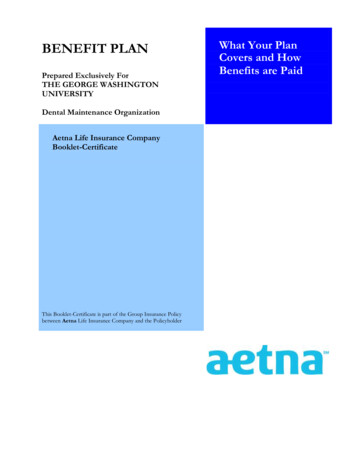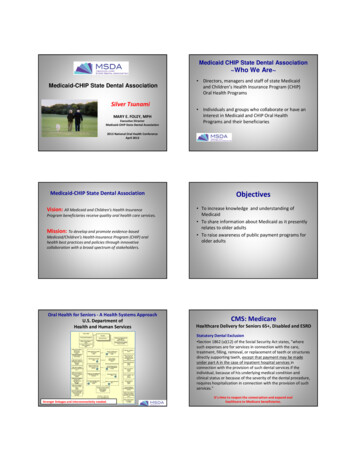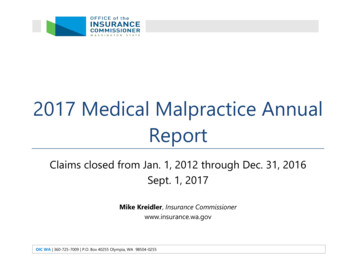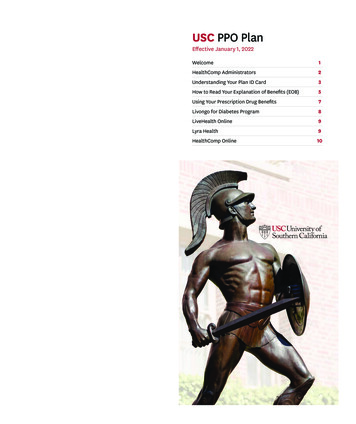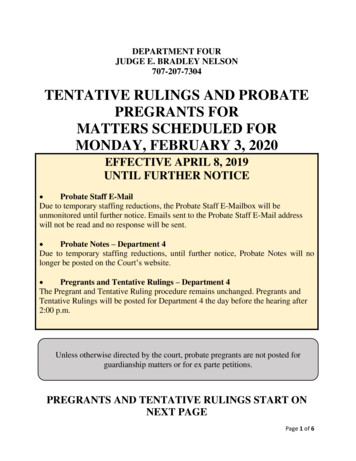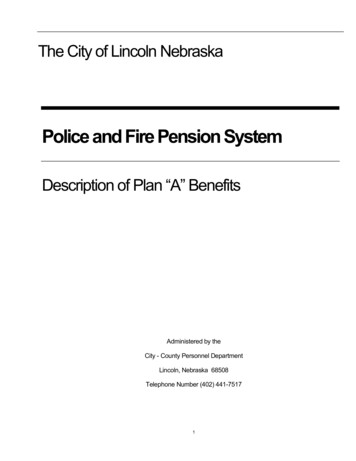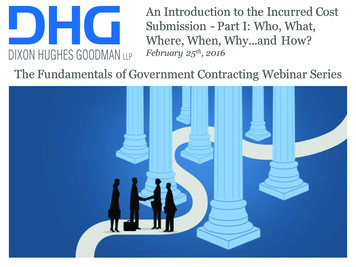
Transcription
An Introduction to the Incurred CostSubmission - Part I: Who, What,Where, When, Why.and How?February 25 th, 2016The Fundamentals of Government Contracting Webinar Seriesgovernment contracting1
Your Presenters@DHG GovConDavid KingDixon Hughes Goodman LLP703.970.0433david.king@dhgllp.comMike MardesichDixon Hughes Goodman LLP703.970.0508mike.mardesich@dhgllp.comgovernment contracting2
Fundamentals of GovernmentContracting at a Glance@DHG GovCon Challenges of Contracting with the FederalGovernment (November 2015) - Completed Contract Types and Associated Risks(December 2015) – Completed Year-End Closing (January 2016) – Completed An Introduction to the Incurred Cost Submission– Part I: Who, What, Where, When, Why, andHow? – You are Here!– Part II: Preparation and Adequacy Review (March2016) Accounting Systems and Setups (April 2016)government contracting3
Fundamentals of GovernmentContracting at a Glance@DHG GovCon Accounting System Adequacy 101 (May 2016) The Composition of Total Cost (June 2016) Making Way for 2017 – Budgeting andProvisional Rates (July 2016) Procurement Systems: DFARS BusinessSystems Rule and Criteria (August 2016) Exploring the Gray Area of Unallowable Costs(September 2016) Policy and Procedures Manual: What’s In It andWhy Do You Need One? (October 2016)government contracting4
Agenda @DHG GovConWhat is an ICS?Who must submit an ICS?Why must I submit an ICS?Where do I submit my ICS?When must I submit an ICS?How do I prepare an ICS?How is the ICS evaluated?How do I prepare for an ICS audit?government contracting5
The Fundamentals of Government Contracting Webinar SeriesWhat is an Incurred CostSubmission (ICS)?government contracting6
What is an ICS?@DHG GovConPer FAR 52.216-7(d) - Allowable Cost and Payment:Final annual indirect cost rates and the appropriate basesshall be established in accordance with Subpart 42.7 of theFAR in effect for the period covered by the indirect cost rateproposal. The Contractor shall submit an adequate final indirectcost rate proposal The proposed rates shall be based on the Contractor’sactual cost experience for that period . An adequate indirect cost rate proposal shall include:government contracting7
What is an ICS?@DHG GovCon(A) Summary of all claimed indirect expense rates, including pool, base,and calculated indirect rate.(B) General and Administrative expenses (final indirect cost pool).Schedule of claimed expenses by element of cost as identified inaccounting records (Chart of Accounts).(C) Overhead expenses (final indirect cost pool). Schedule of claimedexpenses by element of cost as identified in accounting records (Chart ofAccounts) for each final indirect cost pool.(D) Occupancy expenses (intermediate indirect cost pool). Schedule ofclaimed expenses by element of cost as identified in accounting records(Chart of Accounts) and expense reallocation to final indirect cost pools.(E) Claimed allocation bases, by element of cost, used to distributeindirect costs.government contracting8
What is an ICS?@DHG GovCon(F) Facilities capital cost of money factors computation.(G) Reconciliation of books of account (i.e., General Ledger) and claimed directcosts by major cost element.(H) Schedule of direct costs by contract and subcontract and indirect expenseapplied at claimed rates, as well as a subsidiary schedule of Governmentparticipation percentages in each of the allocation base amounts.(I) Schedule of cumulative direct and indirect costs claimed and billed bycontract and subcontract.(J) Subcontract information. Listing of subcontracts awarded to companies forwhich the contractor is the prime or upper-tier contractor (include prime andsubcontract numbers; subcontract value and award type; amount claimedduring the fiscal year; and the subcontractor name, address, and point ofcontact information).government contracting9
What is an ICS?@DHG GovCon(K) Summary of each time-and-materials and labor-hour contract information,including labor categories, labor rates, hours, and amounts; direct materials; otherdirect costs; and, indirect expense applied at claimed rates.(L) Reconciliation of total payroll per IRS form 941 to total labor costs distribution.(M) Listing of decisions/agreements/approvals and description ofaccounting/organizational changes.(N) Certificate of final indirect costs (see 52.242-4, Certification of Final IndirectCosts).(O) Contract closing information for contracts physically completed in this fiscalyear (include contract number, period of performance, contract ceiling amounts,contract fee computations, level of effort, and indicate if the contract is ready toclose).government contracting10
The Fundamentals of Government Contracting Webinar SeriesWho must submit an ICS?government contracting11
Contract Clauses Driving the Submission@DHG GovConClauses commonly found in cost type and time and materials contracts carrycompliance risk. FAR 52.216-7(d), Allowable Cost and Payment––– FAR 42.7, Indirect Cost Rates––– Annual rates and bases “shall be established” based on FAR 42.7“Shall” submit an adequate Rate ProposalClause ((d)(2)(iii)) includes list of schedules to meet adequacyProvides CO with procedures to settle final indirect ratesPrescribes final vouchering process (within 120 days of final rates)Includes “Quick Close-out” (FAR 42.708)FAR 52.232-7, Payments under Time-and-Materials and Labor-Hour Contracts––––Labor is excluded from ICS requirement (Hours and Labor Rates)The “M” is auditableDefines material costs (travel, ODCs, materials, subcontracts, indirect)Pass through costs defined by costs accounting practicesCan be found in Prime and SubcontractsRead and understand your contract!government contracting12
Who is exempt from an ICS? @DHG GovConCommercial ContractsLabor Hour Contracts (No “M”)Fixed Price ContractsContracts closed out under the quick close outprocedure.– When conditions under FAR 42.708(a) aresatisfied Contracting Officer can settle indirectcosts in advance of final indirect cost rate.government contracting13
The Fundamentals of Government Contracting Webinar SeriesWhy must I submit an ICS?government contracting14
Why must I submit an ICS?@DHG GovCon You must submit an ICS because you signed acontract with the a clause that triggers the ICS. The purpose of the ICS is to “true-up” yourProvisional Rates to Actual Rates in order tosettle up on the amount the Government owesyou or the amount you owe the Government(Schedule I)government contracting15
The ICS and the Indirect Rate Cycle@DHG GovCon An ICS is a contractor submission to the Government to “true-up”Provisional Rates to Actual Rates as a part of the Indirect RateCycle.- Contractor Indirect Rate Cycleo Bid and bill with Forward Pricing rateso Monitor the Forward Pricing rates versusActual rates periodically.o Compare the rates at the end of year, atICS submittal, and when the ICS issettled.o Submit revised rates if there is a materialdifference throughout contracto Submit final rates in ICSo Settle final rates at contract closeout Your ICS rates are comprised of costs which are allocable,reasonable, and allowable on Government contracts.government contracting16
Indirect Rate Cycle – Rate Monitoring@DHG GovCon Rates must be monitored by the contractor andmay be adjusted as necessary throughout the year(FAR 42.704(c) and FAR 52.216-7(e))––––Protects the Contractor and the GovernmentReview indirect rates on a regular basisMonitoring Over/Under Billings per contractOnce material rate variances are evident, submitadjusting invoices timely Ensures payment to the contractor prior to exhausting of funding In current budget environment the contractor is wise to recover actualcosts as quickly as possible– No cash flow or financial statement surprises if regularlyreviewedgovernment contracting17
Indirect Rate Cycle - Contract Closeoutgovernment contracting@DHG GovCon18
The Fundamentals of Government Contracting Webinar SeriesWhere do I submit my ICS?government contracting19
Where must I submit an ICS?@DHG GovCon To your cognizant DCMA and DCAArepresentative– FAR 52.216-7(d)(1)(2)(i) - The Contractor shall submitan adequate final indirect cost rate proposal to theContracting Officer (or cognizant Federal agencyofficial) and auditor DCMA Points of Contact– http://www.dcma.mil/DCMAHQ/contact.cfm DCAA Points of Contact– http://www.dcaa.mil/contact us.htmlgovernment contracting20
The Fundamentals of Government Contracting Webinar SeriesWhen must I submit an ICS?government contracting21
When must I submit an ICS?@DHG GovCon126 Days and Counting 6 months after the Contractor fiscal year end– FAR 52.216-7(d)(1)(2)(i) - The Contractor shall submit anadequate final indirect cost rate proposal to the ContractingOfficer (or cognizant Federal agency official) and auditorwithin the 6-month period following the expiration of each ofits fiscal years. Extensions– Reasonable extensions, for exceptional circumstances only,may be requested in writing by the Contractor and granted inwriting by the Administrative Contracting Officergovernment contracting22
When must I submit an ICS?@DHG GovCon MRD 14-PPD-002(R) 2/3/14– DCAA will provide a single late notification letter whenan ICS is days overdue– Starting in Jan ‘15, DCAA will send a list annually tothe DCMA of late proposals or inadequate proposals– DCMA has the option to 1) get adequate proposals or2) unilaterally establish rates per FAR 42.703-2(c)(1)& 42.705(c)(1) with the option of a unilateral costdecrement Increased contractor risk– DCMA can unilaterally decrement your rates ifadequate submissions are not submitted timely.government contracting23
The Fundamentals of Government Contracting Webinar SeriesHow do I prepare an ICS?government contracting24
ICS Project Management@DHG GovCon Establish a project plan for the preparation of your ICS Identification of Milestone projects (i.e., each ICSSchedule) Identification of key parts of each ICS Schedule andresponsible parties Milestone dates (beginning and end) for reviewing andcompleting each project/schedule, and for final reviewand submission of the ICS This webinar should help you get started in preparingyour ICS Please contact us on detailed questions you may haveon certain schedules or any other aspects of the ICSgovernment contracting25
DCAA ICE Model@DHG GovCon ICE Model (Incurred Cost Electronically)– Revised Version 2.0.1E (Released December 2015)– http://www.dcaa.mil/ice model.html– The ICE model is intended to aid the contractor inproviding an adequate submission to DCAA, its use doesnot guarantee that the submission will be judgedadequate. Use of the ICE model is not mandatory Contractors may develop their own template forsubmission however they must contain the requireddata described in FAR 52.216-7 (d)(2)(iii) - AllowableCost and Paymentgovernment contracting26
DCAA ICE Model (continued)@DHG GovCon The ICE model can be tailored to match theindirect rate structure of the contractor. Tabs and formulas are linked so care should betaken to avoid breaking links and formulas. Upon completion all should links and formulasshould be double checked. Not all schedules are mandatory schedules.government contracting27
Before starting ICS prep@DHG GovCon Ensure that your financial reporting canaccurately:– separate direct costs from indirect costs– separate direct costs by contract/task– separate indirect costs by indirect cost pool Verify that you have reliable supportingdocumentationgovernment contracting28
Reporting and Documentation Required for ICS Prep@DHG GovCon Schedules A-G– Trial Balance and General Ledger Detail– Statement of Indirect Expenses / Indirect Rate Calculation Schedule H– Job/Project Summary Reports (at the billing level) For government cost reimbursable and T&M Contract briefs / Whether the contract is a DoD or Non-DoD primeor subcontract Schedule I– Contract revenue by contract type and contract ceiling amounts– Is contract physically complete in the FY of the ICS?– Is contract subject to the penalty clause FAR 52.242-3? Schedule J– Point of contact information and other contract detail includingcosts incurred for flexibly priced subcontractsgovernment contracting29
Reporting and Documentation Required for ICS Prep@DHG GovCon Schedule K– Final year end invoices with cumulative amounts billed for T&Mcontracts including rates and hours billed by labor category Schedule L– Payroll Reconciliation– Year-end payroll summary report– 941 Quarterly Tax Filings Schedule M– Listing of Decisions, Agreements, Approvals, and Description ofAccounting/Organizational Changes Schedule O– Is contract physically complete in the FY of the ICS?– Actual hours incurred for physically complete contracts– contract fee computations, period of performance and contractceiling amountsgovernment contracting30
ICS Preparation@DHG GovCon ICS prep:– Can be frustrating and time consuming even if thecontractor has experience and adequate financialreporting and records.– Requires completion of required schedules– Requires the preparer to use judgment For a walk through of the revised DCAA Incurred CostElectronically (ICE) Model and DCAA AdequacyChecklist please attend Part II of this series on Thursday,March 24thgovernment contracting31
The Fundamentals of Government Contracting Webinar SeriesHow is the ICS evaluated?government contracting32
ICS Evaluation Timeline@DHG GovCon1. Contractor submission of ICS2. DCAA performs adequacy check3. DCAA informs contractor of ICS adequacy orinadequacy- In the event of an inadequate submission the Contractor maycorrect and resubmit4. DCAA risk assessment and audit selection- ICS is selected for audit OR- ICS is dispositioned with a memorandum to the ContractingOfficergovernment contracting33
DCAA Adequacy Checklist@DHG GovConMRD August 27, 2015 – 15-PPD-005(R) - RevisedChecklist for Determining Adequacy of Contractor IncurredCost Proposal Contractors were often concerned that DCAA performs audit stepsin the adequacy review process only to perform them again duringaudit, doubling the effort on contractors. DCAA deleted some checklist items which were not critical todetermine adequacy and expanded some sections related tocompleteness and the overall function and tie-out of the ICS. DCAA has also reinforced its position that auditors use professionaljudgment when making an inadequacy determination and obligatesthem to document and defend an inadequacy determination. May result in less duplicative effort by contractors and fewerinadequacy determinations.government contracting34
DCAA Adequacy Checklist@DHG GovCon Checklist for Determining Adequacy ofContractor Incurred Cost Proposal –Version 3.0 – August 2015:– http://www.dcaa.mil/incurred cost checklist.html For a walk through of the revised DCAA Incurred CostElectronically (ICE) Model and DCAA AdequacyChecklist please attend Part II of this series on Thursday,March 24thgovernment contracting35
DCAA Risk Assessment / Audit Sampling @DHG GovConDCAA determines whether or not an adequate ICS is low or high riskDCAA has a backlog of ICS to audit of over 6 ICS years in some casesMRD January 7, 2016 – 16-PPD-001(R) - Audit Guidance on theImpact of the National Defense Authorization Act on DCAA’s AuditSupport to Non-Defense Agencies– The NDAA prohibits DCAA from providing audit support to non-DoDcustomers unless the Secretary of Defense certifies that the backlog forICS audits is less than 18 months of ICS inventory. As of now, DCAA doesnot meet the requirement. All high risk ICS shall be audited (eventually)If any of the following are true, the ICS is deemed high risk:–––––First ICS from a contractor?Significant questioned costs in prior year ICS audit?Known business system deficiencies that would materially impact rates?Known material risk identified by the Contracting Officer (CO)?Known fraud?government contracting36
DCAA Risk Assessment / Audit Sampling – con’t@DHG GovCon ICS deemed high risk if significant questioned costs in last ICSaudit:– If the last completed incurred cost audit’s ADV (Auditable Dollar Value) is 1M,significant questioned cost is 10% of that year’s ADV– If the last completed incurred cost audit’s ADV is 1M to 5M, significantquestioned cost is 5% of that year’s ADV or 100K, whichever is greater.– If the last completed incurred cost audit’s ADV is 5M to 250M, significantquestioned costs is 250K. ICS deemed low risk are sampled based on ADV.– If the low risk ICS is not selected it is dispositioned with a memo to the CO.Low Risk Adequate Proposals by ADVLess than 1 Million 1 Million - 50 Million 50 Million - 100 Million 100 Million - 250 MillionGreater than 250 MillionLow Risk Sampling Percentages0%5%10%20% (plus an audit every 3 years)100% Contractors should evaluate their own ICS against thesebenchmarks and if “low risk” recommend Quick Closeoutprocedures (FAR 42.708) to the CO.government contracting37
The Fundamentals of Government Contracting Webinar SeriesHow do I prepare for an ICSaudit?government contracting38
Prior to Audit@DHG GovCon During ICS preparation, create an audit packagewith all ICS supporting schedules and backupdocumentation as an audit may not occur for manyyears. Document any assumptions or managementdecisions that are not clear from the supportingschedules as the ICS preparer may no longer bewith your company. Perform DCAA Adequacy checklist and retain withdocumentationgovernment contracting39
Prior to Audit – Frequently Questioned Costs@DHG GovCon Review the submission and ensure the reasonableness andadequate support of frequently questioned costs:– Compensation (Not only executive comp) Document reasonableness 952k vs 487k Blended rates?–––––––BonusEmployee MoraleTravel and EntertainmentMarketingLegalBusiness MeetingsSubcontract costs Poor SOW documentation– Direct labor Labor qualifications for T&M contracts (5-22-14 Audit Alert)– Labor Categories and Resumes Labor Hours - Timekeeping System– Lack of timesheets / inadequate approvalsgovernment contracting40
At the time of audit@DHG GovCon Compile the audit package and have the backup dataavailable in hard copy and electronic format. Establish a single point of contact for all communicationand flow of documentation with the auditor. Request a walkthrough of the audit Conduct periodic updates on the progress of the auditand any open items Be familiar with DCAA Audit procedures– Contract Audit Manual (CAM) Chapter 6 ICS Audit Proceduresgovernment contracting41
The Fundamentals of Government Contracting Webinar SeriesHow long is the Statue ofLimitations?government contracting42
Statute of Limitations (SOL)@DHG GovCon In 1994, Federal Acquisition Streamlining Act (FASA)established a 6 year SOL – FAR 33.206– The CO shall issue a written decision on any Government claiminitiated against a contractor within 6 years after accrual of theclaim, unless the parties agreed to a shorter time period. Does not apply to fraud cases– Accrual of a claim the date when all events, that fix the allegedliability of either the Government or the contractor and permitassertion of the claim, were known or should have been known.– Fix the liability some injury must have occurred (financial orotherwise)– Recent Court Cases demonstrate the SOL is being tested atphases throughout the contract life cycle (Boeing, Raytheon,Alion) The date of submission rather than the date of audit starts the SOL clock(date when claims were known or should have been known) however this isbeing tested in the courts.government contracting43
Backlog Influence on DCAA and Contractors@DHG GovCon The current ICS backlog could cause some ICS years to gounaudited after the expiration of the SOL DCAA is aggressively targeting ICS backlog to minimize SOL issues– This could influence the DCAA to find a contractors ICS inadequate even atthe last minute and force them to update and recertify which would reset the6 year SOL clock.– Contractors should not recertify unless there is a change in their indirectrates. Some contractors have taken bold steps on unaudited ICS over 6years old, such as:– Notify DCAA they have 30 days to take what ever action on the old ICS, andthen records will be destroyed– Refused DCAA access to records on ICS, saying the ICS are no longersubject to audit Consult with your legal and other advisors before taking “bold” stepsgovernment contracting44
Questions?government contracting@DHG GovCon45
The Fundamentals of Government Contracting Webinar SeriesJoin us next month for An Introduction to theICS Part II: Preparation and Adequacy Reviewon Thursday, March 24thgovernment contracting46
government contracting 17 Indirect Rate Cycle - Rate Monitoring @DHG_GovCon Rates must be monitored by the contractor and may be adjusted as necessary throughout the year (FAR 42.704(c) and FAR 52.216-7(e)) - Protects the Contractor and the Government - Review indirect rates on a regular basis - Monitoring Over/Under Billings per .




